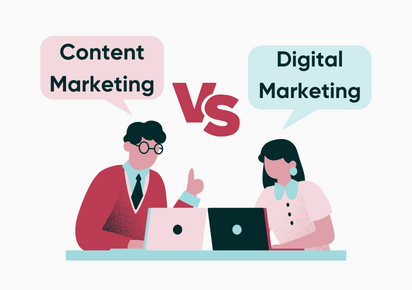Our Links Are Trusted By 2,500+ SEO Agencies
Our Links Are Trusted By 2,500+ SEO Agencies

As the digital world evolves, so does marketing.
Content marketing and digital marketing are two strategies that play a significant role in a business’s online success. However, many people often wonder what is the difference between these marketing strategies.
In this blog post, we will explain the differences between content marketing and digital marketing, the benefits of each strategy, and the strategic advantages of using them together.
Content marketing is a strategic approach centered on creating and distributing valuable, relevant, and informative content. The goal is to increase brand awareness and attract new customers to a website by promoting a business’s products or services.
Examples of content marketing include:
Topical maps are a great way to utilize all three content types. They help to visually organize and connect relevant pieces of content together, making it easier for people to explore and understand the information provided.
A strong content marketing strategy has several benefits, including:
It takes a lot of time and resources to consistently create high quality content, making carrying out comprehensive content marketing strategies a challenge for smaller businesses or those with limited budgets. Not only that but with hundreds of thousands of pieces of content being published every single day, it can be a challenge to create content that stands out from the competition.
Any online marketing activity, including content marketing, is classed as digital marketing. A digital marketing strategy aims to use multiple digital channels to increase brand awareness, promote a business’s products or services, and connect with customers, both current and potential.
An effective digital marketing tactic includes the use of:
As you can see, digital marketers will utilize search engines (like Google and Bing), social media platforms (like Facebook and LinkedIn), and emails to connect with their customers. Unlike traditional marketing methods, digital marketing offers a broader reach and more precise targeting, making it an essential component of any modern marketing strategy.
A strong digital marketing strategy has several benefits, including:
While digital marketing offers numerous benefits, it also comes with its share of challenges. There are over 1.2 billion websites in the world, which makes standing out from the competition extremely difficult. This can make it hard to rank organically for profitable keywords due to these terms having a high difficulty rating, which can also send advertising costs through the roof. Keeping up with industry trends and search engine algorithm changes can also be a challenge. Additionally, succeeding online often requires a significant amount of time, resources, and expertise, which can be a challenge in itself – particularly for smaller businesses that have limited budgets and capabilities.
Content marketing and digital marketing are closely related, however they differ in their approach and focus.
The key difference between content marketing and digital marketing is that while all content marketing falls under the umbrella of digital marketing, not all digital marketing involves content marketing. This is because content marketing only focuses on creating and distributing relevant and informative content, whereas digital marketing utilizes multiple online channels and techniques.
For example, in content marketing, an informative blog post can be created to boost a website’s rankings and traffic. But in the world of digital marketing, this blog post can also be used as a landing page for a bespoke paid ads campaign, be promoted on social media platforms, and be included in a company newsletter to existing customers.
By combining content and digital marketing techniques, businesses can create a cohesive strategy that leverages the strengths of both approaches in order to achieve their business goals and marketing objectives.
Content marketing and digital marketing both play an important role when creating comprehensive marketing strategies.
Combining marketing tactics like PPC and SEO creates a more influential and unified online presence. This is why for any business, it’s vital to develop a balanced marketing strategy that effectively utilizes both marketing methods. This involves:
The ultimate goal is to optimize the customer journey from the awareness stage all the way to conversion.
The first step towards digital marketing success is to establish clear goals and objectives.
These marketing goals should provide clear direction and be closely aligned with the business’s short-term and long-term objectives, such as increasing revenue and improving return on investments. These goals should then be measured through relevant Key Performance Indicators (KPIs).
When setting these goals, it’s important to follow the SMART goal standards – Specific, Measurable, Attainable, Relevant, Time-bound. This will help ensure your goals are attainable within a set time frame and provide a way to measure the success of marketing efforts.
Understanding your target audience is crucial in creating pertinent content and choosing the right marketing channels to target. Your target audience will be the group of people who are most likely to be interested in your product or service. A clearly defined audience is characterized using specific demographics and behavior details, such as:
Creating buyer personas and segmenting the audience into groups based on characteristics like location, interests, and purchase intention helps craft personalized experiences and targeted messaging. By aligning content with the audience’s needs and avoiding segments with low return potential, businesses can optimize their marketing efforts for a better return on investment.
Any successful marketing strategy hinges on the effective allocation of resources and budget. Various budgeting strategies, such as the 70/20/10 rule and ROI-based budgeting help to align marketing efforts with broader business goals. Strategic decisions on budget allocation should be informed by market research, competitive analysis, and evaluating historical campaign performance.
It’s also important that companies maintain flexibility with their marketing budgets, allowing for changes in market dynamics and industry trends. When establishing a marketing budget, is crucial to factor in:
The success of a combined marketing strategy is measured by tracking key performance indicators (KPIs) and adjusting the strategy based on insights from data analysis. Digital technologies and software are also instrumental in refining marketing strategies by providing data via easy-to-view dashboards that highlight campaign performance and identify areas for improvement.
Regularly reviewing content marketing efforts is vital to ensure you know which pieces of content are delivering the best results, either by generating better keyword rankings, website traffic, or online conversions.
Using analytic tools to assess digital marketing strategies will also ensure your other marketing efforts are delivering the results you need. Metrics such as sales revenue, customer retention, and social media engagement serve as key indicators of marketing efficacy.
In addition, monitoring Cost-Per-Click (CPC) and Return on Advertising Spend (ROAS) is essential for evaluating the financial performance of digital advertising campaigns. Site traffic and conversion rates for digital ads also serve as important indicators of successful marketing initiatives and pinpoint areas for improvement.
Key Performance Indicators (KPIs) are how digital marketers measure the success of their marketing campaigns. These metrics aid in the evaluation of marketing campaign effectiveness by reporting on:
Analyzing marketing data and adjusting strategies based on KPI results ensures your digital marketing strategies continue to enhance customer engagement, increase conversion rates, and generate long-term results.
Data and analytics from digital marketing can be used to:
Data analysis tools, such as SEMRush, Moz and Majestic, can be sure to track key KPI indicators and assess the results of each individual marketing activity. By carrying out regular audits and leveraging digital marketing analytics, businesses can make data-driven decisions to optimize marketing budgets, leading to a more effective allocation of resources and ultimately better marketing outcomes.
In conclusion, content marketing and digital marketing, while distinct in their objectives and approaches, are both crucial components of a comprehensive marketing strategy. Combining these two marketing approaches is the best way for a business to drive brand awareness, customer engagement, and sales.
Digital marketing is the key to unlocking online success as it allows businesses to increase their brand visibility and target potential customers across various online platforms, maximizing their online reach and sales potential. Digital marketing also enables businesses to track and measure the results of their efforts. By using analytic tools, businesses can assess how their current campaigns are performing in real time and make the necessary changes to increase the Return On Investment (ROI).
A digital marketing strategy involves promoting products or services through multiple online channels and utilizing strategies such as SEO (Search Engine Optimization), PPC (Pay-Per-Click) advertising, content marketing, video marketing, and email marketing. Whereas a content marketing strategy only focuses on creating and distributing valuable, relevant content to attract, engage, and retain potential customers.
Content marketing focuses on the creation and distribution of multiple content types, such as blog posts, guest posts, infographics, and videos. Whereas social media marketing only involves the use of social media platforms such as Facebook, Instagram, X (formerly Twitter), and LinkedIn. These platforms are then used to promote a business’s products or services, engage with target audiences, and build brand awareness through organic posts and paid advertising campaigns.
To measure the success of their digital marketing efforts, businesses should track KPIs, analyze marketing data, and make data-driven adjustments based on insights gained from the analysis. Regularly analyzing both outbound and inbound marketing results will help ensure each campaign delivers the best return on investment.
In-house digital marketing relies on using existing employees, or hiring a new employee, to carry out the business’s daily marketing tasks. In comparison, outsourced digital marketing involves partnering with an experienced agency or freelancer who will take control of some or all of your marketing tasks, depending on your budget and requirements. Outsourcing marketing is usually the most cost-effective solution as it allows businesses to only pay for the services they need and use.

Join 2,500+ SEO's Who Use Our Link Building Service
Create a free account